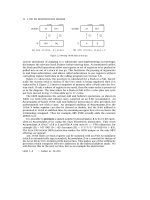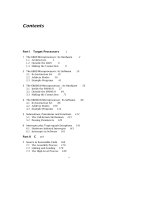Tài liệu Pharmacology for the Health Care Professions pdf
Bạn đang xem bản rút gọn của tài liệu. Xem và tải ngay bản đầy đủ của tài liệu tại đây (2.13 MB, 385 trang )
Pharmacology for the
Health Care Professions
Christine M. Thorp
University of Salford, UK
A John Wiley & Sons, Ltd., Publication
Pharmacology for the Health
Care Professions
Pharmacology for the
Health Care Professions
Christine M. Thorp
University of Salford, UK
A John Wiley & Sons, Ltd., Publication
This edition first published 2008 2008 by John Wiley & Sons, Ltd.
Wiley-Blackwell is an imprint of John Wiley & Sons, formed by the merger of Wiley’s global Scientific,
Technical and Medical business with Blackwell Publishing.
Registered office: John Wiley & Sons Ltd, The Atrium, Southern Gate, Chichester, West Sussex, PO19 8SQ,
UK
Other Editorial Offices:
9600 Garsington Road, Oxford, OX4 2DQ, UK
111 River Street, Hoboken, NJ 07030-5774, USA
For details of our global editorial offices, for customer services and for information about how to apply for
permission to reuse the copyright material in this book please see our website at
www.wiley.com/wiley-blackwell
The right of the author to be identified as the author of this work has been asserted in accordance with the
Copyright, Designs and Patents Act 1988.
All rights reserved. No part of this publication may be reproduced, stored in a retrieval system, or transmitted,
in any form or by any means, electronic, mechanical, photocopying, recording or otherwise, except as
permitted by the UK Copyright, Designs and Patents Act 1988, without the prior permission of the publisher.
Wiley also publishes its books in a variety of electronic formats. Some content that appears in print may not
be available in electronic books.
Designations used by companies to distinguish their products are often claimed as trademarks. All brand
names and product names used in this book are trade names, service marks, trademarks or registered
trademarks of their respective owners. The publisher is not associated with any product or vendor mentioned
in this book. This publication is designed to provide accurate and authoritative information in regard to the
subject matter covered. It is sold on the understanding that the publisher is not engaged in rendering
professional services. If professional advice or other expert assistance is required, the services of a competent
professional should be sought.
Library of Congress Cataloging-in-Publication Data
Thorp, Christine.
Pharmacology for the health care professions / Christine Thorp.
p. ; cm.
Includes bibliographical references and index.
ISBN 978-0-470-51018-6 (hb : alk paper) – ISBN 978-0-470-51017-9 (pb : alk paper)
1. Pharmacology. 2. Chemotherapy. I. Title.
[DNLM: 1. Pharmaceutical Preparations. 2. Drug Therapy. 3. Pharmacology. QV 55 T517p 2008]
RM300.T52 2008
615
.1–dc22
2008021458
ISBN: 978-0-470-51018-6 (HB)
ISBN: 978-0-470-51017-9 (PB)
A catalogue record for this book is available from the British Library
Typeset in 10/12pt Times by Laserwords Private Limited, Chennai, India
Printed and bound in Singapore by Markono Print Media Pte Ltd
First impression 2008
This book is dedicated to
thememoryofmymother
Contents
Foreword xiii
Preface xv
Acknowledgements xvii
1 Introduction 1
1.1 Pharmacology and health care professionals 2
1.2 Patient compliance 4
1.3 Drug names 4
Part I Principles of pharmacology 7
2 Drug disposition 9
2.1 Chapter overview 9
2.2 Administration of drugs 9
2.3 Absorption of drugs 13
2.4 Drug distribution 17
2.5 Drug metabolism 20
2.6 Excretion of drugs 23
2.7 Summary 26
3 Effects of drugs on the body 29
3.1 Chapter overview 29
3.2 Adverse reactions to drugs 29
3.3 Variation in response to drug therapy 36
3.4 Targets for drug action 40
3.5 Summary 45
Part II Systemic pharmacology 49
4 Cardiovascular and blood disorders 51
4.1 Cardiovascular disorders 51
viii CONTENTS
4.2 Hypertension 58
4.3 Drugs used to treat cardiovascular disorders 60
4.4 Blood disorders 68
4.5 Anaemias 73
4.6 Lipid metabolism 75
4.7 Lipid-lowering drugs 77
4.8 Summary 79
5 Respiratory Disorders 85
5.1 Chapter overview 85
5.2 Asthma 88
5.3 Chronic bronchitis 88
5.4 Drugs used to treat respiratory disorders 89
5.5 Treatment of other respiratory conditions 92
5.6 Summary 94
6 Disorders of the endocrine system 99
6.1 Chapter overview 99
6.2 Pituitary gland 99
6.3 Thyroid gland 102
6.4 Parathyroid glands 104
6.5 Adrenal glands 105
6.6 Pancreas 106
6.7 Treatment of diabetes mellites 108
6.8 Summary 111
7 Disorders of the musculoskeletal system 115
7.1 Chapter overview 115
7.2 Rheumatic diseases 115
7.3 Drugs used to treat rheumatic diseases 116
7.4 Gout 123
7.5 Drugs used to treat gout 124
7.6 Osteoarthritis 125
7.7 Paget’s disease 126
7.8 Treatment of Paget’s disease 126
7.9 Osteoporosis 127
7.10 Drugs used to treat osteoporosis 127
7.11 Osteomalacia 128
7.12 Myasthenia gravis 128
7.13 Treatment of myasthenia gravis 129
7.14 Motor neuron disease and multiple sclerosis 130
7.15 Summary 132
CONTENTS ix
8 Disorders of the skin 137
8.1 Chapter overview 137
8.2 Eczema 138
8.3 Treatment of eczema 139
8.4 Psoriasis 140
8.5 Treatment of psoriasis 141
8.6 Warts 144
8.7 Treatment of warts 145
8.8 Other viral infections of the skin 146
8.9 Fungal infections of the skin and nails 146
8.10 Drugs used to treat fungal infection of the skin and nails 147
8.11 Bacterial infection of the skin 150
8.12 Summary 151
9 Chemotherapy of infectious diseases 155
9.1 Chapter overview 155
9.2 Bacteria 155
9.3 Antibiotic drugs 157
9.4 Treatment of tuberculosis 160
9.5 Viruses 161
9.6 Antiviral drugs 162
9.7 Treatment of HIV infection 165
9.8 Fungi 165
9.9 Antifungal drugs 166
9.10 Protozoa 168
9.11 Antimalarial drugs 169
9.12 Drugs for toxoplasma and pneumocystis pneumonia 170
9.13 Parasitic worms 170
9.14 Anthelmintics 172
9.15 Summary 173
10 Cancer chemotherapy 177
10.1 Chapter overview 177
10.2 Biology of cancer 177
10.3 Principles of chemotherapy 180
10.4 Drugs used in cancer chemotherapy 182
10.5 Summary 188
11 Disorders of the central nervous system 191
11.1 Chapter overview 191
11.2 Affective disorders 194
11.3 Drugs used to treat depression 198
x CONTENTS
11.4 Drugs used to treat bipolar depression and mania 200
11.5 Psychoses 201
11.6 Drugs used to treat schizophrenia 203
11.7 Anxiety and insomnia 205
11.8 Anxiolytics and hypnotics 207
11.9 Treatment of anxiety 207
11.10 Treatment of insomnia 209
11.11 Attention deficit hyperactivity disorder (ADHD) 210
11.12 Treatment of ADHD 211
11.13 Parkinson’s disease 211
11.14 Drugs used to treat Parkinson’s disease 213
11.15 Epilepsy 216
11.16 Drugs used to treat epilepsy 217
11.17 Alzheimer’s disease 221
11.18 Treatment of Alzheimer’s disease 221
11.19 Summary 221
12 Anaesthesia and analgesia 229
12.1 Chapter overview 229
12.2 General anaesthesia 229
12.3 Inhalation anaesthetics 231
12.4 Intravenous anaesthetics 232
12.5 Premedication and adjuncts to general anaesthesia 234
12.6 Local anaesthesia 236
12.7 Local anaesthetics 241
12.8 Analgesia 243
12.9 Peripherally acting analgesics 244
12.10 Centrally acting analgesics 247
12.11 Neuropathic pain 247
12.12 Summary 248
13 Contrast agents and adjuncts to radiography 253
13.1 Chapter overview 253
13.2 Contrast agents 253
13.3 Cautions in use of contrast agents 257
13.4 Complications of intravenous administration of contrast agents 257
13.5 Adverse reactions to contrast agents 257
13.6 Management of acute adverse reactions to contrast agents 259
13.7 Adjuncts to radiography 260
13.8 Summary 264
CONTENTS xi
Part III Prescribing and the law 269
14 Medicines, the law and health care professionals 271
14.1 Chapter overview 271
14.2 Legislation 271
14.3 Non-medical prescribing 279
14.4 Summary 284
15 Prescribing in practice 291
15.1 Chapter overview 291
15.2 Podiatry 291
15.3 Extension of access to prescription-only medicines
in podiatry and podiatic surgery 292
15.4 Podiatry in the community 299
15.5 Radiography 300
15.6 Medicines in radiography: prescription, supply and administration 300
15.7 Physiotherapy 315
15.8 Summary 319
Appendices 321
Appendix A: Drug Names 323
Appendix B: Glossary 331
Appendix C: Examples of Patient Group Directions 337
Bibliography 343
Useful websites 345
Index 349
Foreword
Students of pharmacology are well served by a number of academic textbooks on their
subject but the majority are written from a traditional academic viewpoint. This new book
is different in that it is written specifically for the audience of the Health Care Professions
and the author Dr Christine Thorp is particularly well qualified in this respect.
Dr Thorp graduated from the School of Pharmacy and Pharmacology at the University
of Bath, first with a BSc in 1975 and then with a PhD in 1979 providing her with a
traditional academic view of pharmacology and experience of research. Since then she
has undertaken a number of roles, most recently in the Faculty of Health and Social Care
at the University of Salford, with responsibility for teaching pharmacology to students
in a variety of Health Care Profession disciplines.
Dr Stephen Moss BPharm, MSc, PhD, FRPharmS
Department of Pharmacy and Pharmacology
University of Bath
July 2008
Preface
The need for a book such as this one has arisen as a result of recent changes in legislation
and expansion in the numbers of health care professionals involved in administration
and/or prescription of medicines.
The book is an introduction to pharmacology for health care professionals. Although
anyone involved in the care of patients is a health care professional, this book has been
specifically written for physiotherapists, podiatrists and radiographers (otherwise known
as allied health professionals). However, the book may be of interest to other health care
professionals.
The book aims to provide the knowledge of pharmacology necessary for under-
graduates of all three professions and practitioners on post graduate programmes for
accreditation of supplementary prescribing or access and supply of prescription-only
medicines. It may also be of more general use to any health care professional involved
in patient care, especially those who administer medicines under patient group directions.
The book is arranged into three parts. In the first part, Principles of Pharmacology,
two chapters cover administration, absorption, distribution, metabolism and excretion of
drugs (Chapter 2) and adverse drug reactions, drug–drug interactions, individual response
to drugs and targets for drug action (Chapter 3).
The second part is Systemic Pharmacology, which covers common disorders of the
major body systems and their treatment. The cardiovascular, respiratory, endocrine, mus-
culoskeletal, skin and central nervous systems are considered. An outline of normal
physiology of the systems is included where appropriate and relevant diseases described
briefly. This is not intended to be a physiology book or a pathophysiology book. Should
the reader need to consult such books, suggestions are given in the bibliography. Major
groups of drugs are discussed, with emphasis on areas of relevance to the three professions
for whom the book is intended.
In addition to drugs used to treat diseases of the major systems, the treatment of
infections and parasites, the use of cancer chemotherapy, the use of anaesthetics and
analgesics and the use of contrast agents and adjuncts to radiotherapy are included in
Part 2.
The final part has two chapters. The first of the two (Chapter 14) is about legislation
around the use of medicines with discussion of salient points from the Medicines Act
1968 and the Misuse of Drugs Act 1971. Specific exemptions for podiatrists, the use of
patient group directions, supplementary prescribing and independent prescribing and a
brief history of non-medical prescribing are considered.
The final chapter (Chapter 15) ‘Prescribing in Practice’ consists of contributions from
podiatry, radiography and physiotherapy colleagues. They have described the use of
xvi PREFACE
various forms of access, supply, administration and prescription of medicines in their
professions today and considered future developments in the light of the recent legislation
allowing pharmacists and nurses to train as independent prescribers. Hopefully this will
give the reader a realistic view of what is currently happening and what might happen
in non-medical prescribing.
Useful web sites are listed at the end of each chapter, to encourage the reader to use
the Internet for sources of reliable and respectable up-to-date information about disease,
medicines and therapeutics. Although all websites were accessible at the time of writing,
their existence cannot be guaranteed in the future.
Each chapter is followed by one or more case studies to illustrate the clinical use of
drugs and problems that may arise from drug–drug interactions and adverse reactions.
The situations are not based on any particular individuals; rather information has been
gathered from many sources including my colleagues in physiotherapy and podiatry and
used to construct the cases.
Finally, the chapters are finished off with review questions to test the reader’s under-
standing of key concepts.
In the appendices, a list of drug names with their main therapeutic uses and a glossary
of key terms used in the text are provided.
Drugs in current use are not all covered in this text; neither is this work intended as a
recommendation for any drug use. Professionals should always consult the latest edition
of the British National Formulary for definitive information about medicines.
Acknowledgements
I would like to thank friends and colleagues who encouraged and supported me in the
writing of this book from its early inception through to final completion. I especially
want to thank Leah Greene for her technical expertise and unfailing assistance with com-
puter applications. I am grateful to Alison Barlow and Peter Bowden for their helpful
ideas with matters relating to podiatry and Louise Stuart, MBE (Consultant Podiatrist)
for an insight into supplementary prescribing; to Jan Dodgeon for help with topics rel-
evant to radiography and Chris Frames and Chris O’Neal for their help with devising
physiotherapy case studies.
Special thanks are due to those who contributed to Chapter 15, namely Professor
Peter Hogg (Nuclear Medicine) and his co-authors, and Anthony Waddington (Podiatric
Surgeon). Without their experience in practice this book would have had far less relevance
to the health care professionals for whom it was written.
I have to thank students past and present for their inspiration, comments and sug-
gestions over the years and I hope future students and practitioners will benefit from
this.
Thanks to staff at Wiley (in particular Rachael Ballard, Fiona Woods and Jon Peacock),
to Neil Manley for creating the index, and to Wendy Mould, who copyedited the book.
Finally, thanks to Alex for his understanding and patience.









